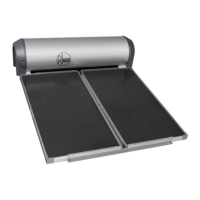60
CONNECTIONS – ELECTRICAL
The power supply to the water heater must not be switched on until the water heater is filled with water
and a satisfactory megger reading is obtained.
All electrical work and permanent wiring must be carried out by a qualified person and in accordance with the
edition of the Wiring Rules AS/NZS 3000 in force in the state or territory at the time of installation, and all local
codes and regulatory authority requirements.
If this water heater is installed with an in-series booster, then the electric booster heating unit will not need to
be connected to a power supply and the references to the electric booster heating unit, thermostat and boosting
controls in these installation instructions will not be applicable to the installation.
Note: AS 3498 requires that a water heater provides the means to inhibit the growth of Legionella bacteria in
potable water. This water heater can satisfy this AS 3498 requirement provided, where an in-series booster
water heater is not installed, the electric booster is energised for a sufficient period each day and the electric
booster thermostat setting is at least 60°C.
SOLAR STORAGE TANK
The solar storage tank with an electric booster heating unit must be directly connected to a 220 V - 240 V a.c.
50 Hz mains power supply with an isolating switch installed at the switchboard. The Wiring Rules AS/NZS 3000
requires a second and lockable isolating switch be installed adjacent to but not on or attached to the solar
storage tank, and a residual current device (RCD) installed in the electrical circuit to the water heater.
A flexible 20 mm conduit is required for the electrical cable to the solar storage tank. The conduit is to be
connected to the unit with a 20 mm terminator.
Connect the power supply wires directly to the terminal block and earth tab connection, ensuring there are no
excess wire loops inside the front cover. The temperature rating of the power supply wires insulation must suit
this application, or the wiring protected by insulating sleeving with an appropriate temperature rating if it can
make contact with the internal storage cylinder. The temperature of the internal storage cylinder can reach
95°C during its operation.
The water heater is more suited for the booster heating unit to be connected to either a continuous, or a time
of use, or an extended Off-Peak (overnight and day) electricity supply. A timer can also be used to control the
boosting periods and help maximise solar savings. Refer to “Booster Control” on page 61.
The booster heating unit may be connected to an Off-Peak (overnight) electricity supply, however this will only
allow the booster to heat the water overnight. If this type of connection is considered, care must be taken to
ensure there is sufficient boost capacity to meet the household’s full day and night’s hot water supply during
periods of no or low solar gain, particularly in cold weather. Temperature Redistribution (refer to page 23) is
more evident with this type of electricity supply connection and its implications should be discussed with the
householder.
Discuss the power supply and hot water usage requirements with the householder.
If water and / or power are not available on completion of installation, leave the isolation switch in the meter
box in the off position and place a warning label “Do not turn on electricity until the water heater is filled with
water and the water heater has been commissioned” on the electrical isolating switch.
THERMOSTAT SETTING
The thermostat is adjustable from 60°C to 70°C. The factory setting of the thermostat is 60°C. The thermostat
is adjusted by turning the adjuster anticlockwise to decrease the temperature setting and clockwise to increase
the temperature setting. Only adjust the temperature setting when the isolating switch is switched off at the
switchboard.
The thermostat has a safety cut-out (also called an over-temperature energy cut-out) that will de-energise the
element should the temperature within the tank reach 83°C whist the element is activated. This safety cut-out
is not resettable. This cut-out is of a type that will not activate due to solar heating of the water in the storage
tank above this temperature whilst the element is not energised.

